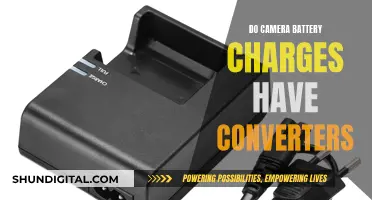
Camera batteries are essential for photographers, especially when travelling or shooting long events such as weddings. While many digital cameras used to rely on disposable batteries, most now feature rechargeable batteries, which are more environmentally and budget-friendly. The most common type of camera battery is lithium-ion, which is also used in cell phones, laptops, electric vehicles, and other high-tech gadgets. Other types of batteries used in cameras include nickel-metal-hydride and disposable AA and AAA batteries. It is important to note that not all camera batteries are created equal, and it is crucial to use the correct type of battery to avoid compatibility problems. Additionally, it is recommended to purchase batteries from reputable manufacturers to ensure safety and effectiveness.
What You'll Learn
- Camera batteries are made of lithium-ion, nickel-metal-hydride, or alkaline
- Lithium-ion batteries are used in digital cameras, cell phones, and laptops
- Nickel-metal-hydride batteries are rechargeable and have a high energy density
- Alkaline batteries are common in AA and AAA sizes but aren't ideal for high-power devices
- Third-party batteries are cheaper but may be unreliable and damage your camera

Camera batteries are made of lithium-ion, nickel-metal-hydride, or alkaline
Lithium-ion batteries are the most common type of camera battery and are used in a variety of devices, from cell phones to electric vehicles. They are small but powerful, and their rechargeable nature makes them environmentally and budget-friendly.
Nickel-metal-hydride batteries are another option for digital cameras. These batteries have a high energy density, allowing them to store more energy in the same amount of space as traditional batteries. However, they are heavier than lithium-ion batteries, making them less common in camera battery packs.
Disposable alkaline batteries are often used in AA and AAA battery sizes and are suitable for low-power devices like flashlights and remote controls. While they are not ideal for high-power devices like cameras, they can serve as backup or secondary batteries.
When choosing a camera battery, it is important to consider the specific requirements of your camera model, as different cameras have different battery needs, even within the same brand. Additionally, while third-party batteries are often more affordable, it is crucial to prioritize quality and safety to avoid potential issues and ensure the longevity of your camera equipment.
Tasco Trail Camera: Loading Batteries for Optimum Performance
You may want to see also

Lithium-ion batteries are used in digital cameras, cell phones, and laptops
Lithium-ion batteries are used in a wide range of electronic devices, from digital cameras to cell phones and laptops. They are rechargeable and can be recharged and reused hundreds of times before deteriorating. This makes them a popular choice for devices that require frequent recharging, such as cell phones and laptops.
Lithium-ion batteries offer several advantages over other types of batteries. They have a high energy density, which means they can store more energy in a smaller space. This makes them ideal for portable devices like cameras, where size and weight are important factors. Lithium-ion batteries also have a long shelf life, typically lasting 2 to 3 years, and can hold their charge for a long time, losing only around 5% of their power each month when not in use.
In digital cameras, lithium-ion batteries provide a robust power source, allowing photographers to capture hundreds of photos or videos on a single charge. They are also commonly used in DSLR and mirrorless cameras due to their small size and large power capacity. Additionally, some camera manufacturers stick to a specific lithium-ion battery design for multiple generations of cameras, allowing photographers to continue using the same batteries even when they upgrade their equipment.
Cell phones heavily rely on lithium-ion batteries to provide power for various functions, including phone calls, internet browsing, and multimedia applications. These batteries are lightweight and efficient, making them suitable for the compact designs of modern smartphones.
Laptops also utilize lithium-ion batteries to deliver the necessary power for computing tasks. Their rechargeable nature is particularly advantageous for laptops, as it eliminates the need for frequent battery replacements.
It is important to note that while lithium-ion batteries offer numerous benefits, they should be handled with care. They can be damaged by extreme temperatures, and proper storage at room temperature is recommended. Additionally, when flying, lithium-ion batteries should be carried in carry-on baggage, and passengers should notify the flight crew if any issues, such as overheating or smoking, are observed.
Charging the Panasonic Leica Dicomar Camera: A Step-by-Step Guide
You may want to see also

Nickel-metal-hydride batteries are rechargeable and have a high energy density
Nickel-metal-hydride batteries, also known as NiMH or Ni–MH batteries, are a type of rechargeable battery with a high energy density. They are commonly used in digital cameras and other high-drain devices, offering superior performance to primary batteries such as alkaline batteries. NiMH batteries have a higher energy density than traditional batteries, allowing them to store two to three times more energy in the same amount of space. This makes them ideal for devices that require a robust power source, such as digital cameras.
NiMH batteries have a nominal voltage of 1.2 V per cell, with a starting voltage of around 1.4 volts for a freshly charged AA NiMH cell. They can deliver high current levels without a significant loss in capacity, making them suitable for devices like digital cameras with LCDs and flashlights, which can draw over 1 ampere.
One of the key advantages of NiMH batteries is their environmental friendliness. They contain only mildly toxic substances and are recyclable, addressing the global demand for rare earth elements (REEs). Additionally, NiMH batteries use a hydrogen-absorbing alloy for the negative electrode instead of toxic materials like cadmium, making them safer for both use and disposal.
NiMH batteries also offer improved cycle life compared to other battery types. They can withstand repeated charge and discharge cycles without significant degradation, although they do experience a self-discharge rate of about 1% per day in low-energy consumption devices. This self-discharge rate can be managed using battery management systems (BMS) or trickle charging, ensuring the battery remains at its maximum capacity.
In summary, NiMH batteries are a popular choice for digital cameras due to their rechargeable nature, high energy density, and environmental benefits. They provide a cost-effective solution with good cycle life performance and safety, making them a preferred option over lithium-ion batteries in certain applications.
Charging the Polaroid Snap Touch: A Step-by-Step Guide
You may want to see also

Alkaline batteries are common in AA and AAA sizes but aren't ideal for high-power devices
Alkaline batteries are the most common type of AA and AAA battery technology. They are economical, easy to dispose of, and extremely popular. They are best suited for low-power-consumption gadgets like flashlights, calculators, and remote controls.
Alkaline batteries are not ideal for high-power devices like smartphones and cameras. They have a lower energy density than lithium batteries, which means they store less energy and provide lower performance. Lithium batteries, on the other hand, have a higher energy capacity and are more suitable for high-drain devices.
Alkaline batteries also have a shorter shelf life than lithium batteries. While alkaline batteries have a shelf life of up to 10 years, lithium batteries can last up to 15 years, and some brands can even last 20 years. This makes lithium batteries more cost-effective and environmentally friendly in the long run.
Additionally, alkaline batteries are heavier than lithium batteries. Lithium is the lightest metal and lightest solid element under standard conditions, making lithium batteries 33% lighter than alkaline batteries. This weight difference makes lithium batteries more suitable for portable devices, while alkaline batteries are a better choice for corded items.
Another factor to consider is internal resistance. Alkaline batteries have a high internal resistance, which causes the voltage to drop, making them suitable only for low-drain items. On the other hand, lithium batteries have a low internal resistance and a flat discharge curve, making them capable of handling moderate to heavy loads.
In summary, while alkaline batteries are widely used and easily accessible, they are not the best option for high-power devices like cameras. Their lower energy density, shorter shelf life, higher weight, and high internal resistance make them less ideal for devices that require a significant amount of power. For devices like cameras, lithium batteries or rechargeable batteries are more suitable options.
Charging the XP Waterproof Camera: A Step-by-Step Guide
You may want to see also

Third-party batteries are cheaper but may be unreliable and damage your camera
Camera batteries have come a long way, with improvements in technology leading to faster recharge times, higher charge capacities, and longer lifespans. While most modern cameras have shifted to rechargeable batteries, there are still some that use disposable batteries.
When it comes to rechargeable batteries, there are two main options: first-party batteries and third-party batteries. First-party batteries are those made by the camera manufacturer or a licensed company. These batteries tend to be more expensive but typically come with certain assurances of quality and compatibility. On the other hand, third-party batteries are produced by companies other than the camera manufacturer and can vary widely in terms of quality and price.
While third-party batteries may be tempting due to their lower cost, it's important to exercise caution. Some third-party batteries may be unreliable and prone to losing charge quickly. In rare cases, they could even damage your camera.
One of the main issues with third-party batteries is the potential for lower manufacturing standards. To save costs, some manufacturers may cut corners on materials, testing, and design, resulting in inferior products. This can lead to batteries that don't hold their charge well, have a shorter lifespan, or, in extreme cases, malfunction and damage your camera.
Additionally, third-party batteries may not always be compatible with your camera. Camera manufacturers often upgrade their batteries, and third-party options may not keep up with these changes. In some cases, firmware updates to your camera can even render third-party batteries incompatible, as companies sometimes use these updates to "fix" battery problems while also locking out non-official batteries.
When considering third-party batteries, it's crucial to do your research. Look for reputable manufacturers and dealers, and check reviews from other photographers. While you may save money upfront, keep in mind that you could end up with a battery that doesn't work as expected or, worse, causes damage to your camera.
To summarise, while third-party batteries can be a more affordable option, they may come with risks. It's important to balance cost savings against the potential for unreliable performance and possible damage to your camera.
Camera Battery Life: AA Power Explained
You may want to see also
Frequently asked questions
Camera batteries are made of different materials depending on the type of battery and the manufacturer. Common materials include lithium-ion, nickel-metal hydride, and alkaline.
No, not usually. Each camera model usually requires a specific type of battery that is designed to fit that particular camera. However, some cameras use universal battery formats such as AA or AAA batteries, which can be interchanged.
A third-party or off-brand camera battery is one that is made by a company other than the original manufacturer of the camera. These batteries are usually cheaper but may not always be as reliable as the original batteries.
When purchasing a third-party battery, it is important to check the compatibility with your camera model. Compare the battery type and model number to ensure it is compatible with your camera.
To make your camera battery last longer, avoid extreme temperatures, don't fully charge or drain the battery, and store it at room temperature when not in use. Additionally, try to avoid using battery-intensive features on your camera, such as the LCD screen.







